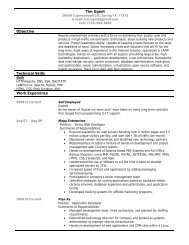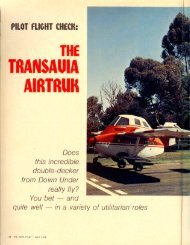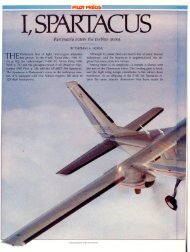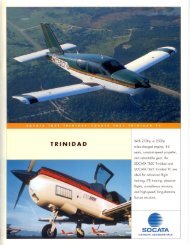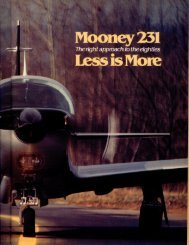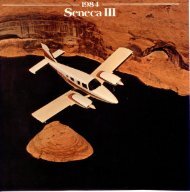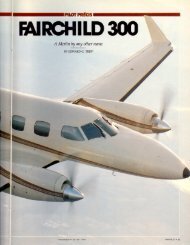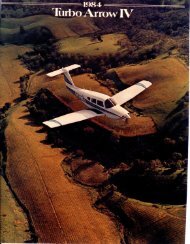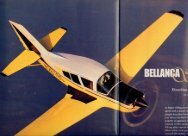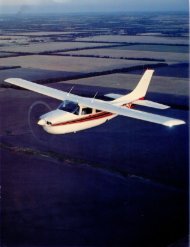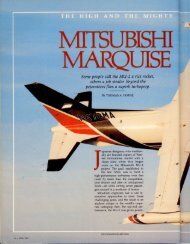comanche spoiter's guide - Aero Resources Inc
comanche spoiter's guide - Aero Resources Inc
comanche spoiter's guide - Aero Resources Inc
- No tags were found...
You also want an ePaper? Increase the reach of your titles
YUMPU automatically turns print PDFs into web optimized ePapers that Google loves.
continuedthat any single-engine airplane that could leave passengerssmiling after an"all-day flight was worthy of praise.That trip also left me with pleasant thoughts about theComanche's flying characteristics. The flight controls arebeautifully balanced. Pilots who are apprehensive aboutwrestling with a high-performance single will be bowledover by the smooth, easy handling of the Comanche.My euphoria ended on the landing flare. The Comancheis a floater, and it also is easy to touch down nosewheelfirst. The flaps extend to 32 degrees on 1962 and later Comanches,and the main gear struts are short, so a springycushion of ground effect piles up underneath the airplane toforestall the touchdown. Comanche pilots have developedseveral techniques for minimizing float and a wheelbarrowlanding. One is to retract the electric flaps during the flare.However, this procedure rates a thumbs down from manyinstructors. Aircraft accident statistics are replete with incidentsof pilots reaching for the flap switch but activating thegear-up switch instead.Some Comanche pilots complain that retracting the flapson the flare leads to an "arrival" or firm landing rather thana smooth touchdown. Their solution to the float is to pumpup the main gear struts to increase ground clearance. On theramp, a Comanche sits in a tail-low attitude, which meansthat, on landing, the pilot has to get the nose up very highto ensure that the main wheels touch first.There are other quirks. The takeoff roll can seem interminable.The Comanche requires a lot of speed before thelong, narrow wing generates enough lift for rotation andclimb-out. Also, early model Comanches have flight instrumentsarranged in a non-standard pattern. Engine instrumentsand fuel gauges are located on the right side of thepanel, where they are difficult to monitor. Unless the panelhas been updated, gyro instruments very well may be militarysurplus relics.Piper built seven versions of the PA-24, beginning withthe 180 in 1958. The horsepower increased in steps, from180 to 250 in 1958, to 260 in 1964, to a flirtation with 400hp in 1964 and 1965 and, finally, to a twin-turbocharged260-hp Comanche in models from 1970 through 1972.Although 180 hp does not seem to be quite enough for afour-place airplane with a gross weight of 2,500 pounds, thePA-24-180 proved to be quite popular. There were 1,143built between 1958 and 1964. The trade-off for a lowerclimb rate, slower cruise speeds and less payload in the 180,compared to the 250 and 260 Comanches, is lower operatingcost. The four-cylinder Lycoming 0-360 is more fuelefficientthan the 250- and 260-hp six-cylinder Lycoming 0540s and 10-540s, and the overhaul is less expensive.The Comanche 180 maintains respectable cruise speeds,thanks to the efficient wing and a constant speed propeller.At 55 percent power, the 180 should cruise at 116 knotswhile using only 7.5 gph. At 75 percent power, speed increasesto 139 knots, with a fuel flow of 10 to 11 gph.The Comanche's performance increased dramatically withthe introduction of the 250. Cruise speeds at all powersettings jumped 20 knots, and the climb rate increased morethan 50 percent, to 1,400 fpm. Although the 250 is heavierthan the 180, useful load increased 125 pounds. Piper beganoffering two IS-gallon outboard wing tanks as an option onboth the 180 a,nd 250 Comanches in 1961. With full tanks90 gallons-the 250 could cover more than 1,000 nm.In 1964, fuel injection, another 10 hp and 100 pounds38. FEBRUARY 1985



